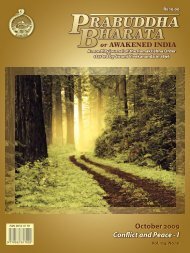P
PB Cover July 2011.indd - Advaita Ashrama
PB Cover July 2011.indd - Advaita Ashrama
- No tags were found...
Create successful ePaper yourself
Turn your PDF publications into a flip-book with our unique Google optimized e-Paper software.
The Five Great Sacrifices:<br />
Linking Ancient and Modern Hinduism<br />
Swami Samarpanananda<br />
PB July 2011<br />
With massive social, economic,<br />
and political changes all over the<br />
world the daily religious devotions that<br />
were practised by the ancestors of the Hindus<br />
have become cumbersome in today’s world.<br />
Moreover, the modern generation bereft of ancient<br />
traditions find itself at a loss in explaining<br />
what Hinduism, and religion in general, really<br />
is. There is unanimity, however, in the belief in<br />
God having many forms, reincarnation, karma,<br />
dharma, creation in cycles, and the infinity of<br />
time. Further, the belief in the Vedas as sacred<br />
and Om as the symbol of God, along with veneration<br />
of the guru, Gaya, Ganga, Gayatri, and<br />
go, cow, is prevalent. Beliefs apart, Hinduism has<br />
now boiled down to performing samskaras—<br />
sacraments—and puja, either at home or in a<br />
temple; occasionally attending satsanga, holy<br />
company; singing and listening to bhajans, devotional<br />
songs; watching digitalized mythological<br />
tales; observing fasts, ritual cleanliness, and some<br />
food habits; and a few other activities put forward<br />
by the many sampradayas, traditions, that<br />
were born and grew during the last century.<br />
One of the trends in the ways Hinduism is followed<br />
at present is the wrong notion that rituals<br />
have become irrelevant in today’s world. When<br />
Swami Vivekananda was in London, in 1895, two<br />
visitors came to see him, about whom he wrote<br />
to Mr E T Sturdy: ‘Both of them want to know<br />
the rituals of my creed! This opened my eyes. The<br />
world in general must have some form. In fact, in<br />
the ordinary sense religion is philosophy concretized<br />
through rituals and symbols. It is absolutely<br />
necessary to form some ritual and have a Church.<br />
That is to say, we must fix on some ritual as fast as<br />
we can. … We will fix something grand, from birth<br />
to death of a man. A mere loose system of philosophy<br />
gets no hold on mankind.’1 Later Swamiji<br />
spoke about having a new Smriti, religious code<br />
of conduct, framed for the present age.2 Although<br />
Swamiji asked one of his disciples to produce a<br />
modern Smriti, the project never materialized.<br />
And if this is ever to happen, we have to first<br />
understand what links the various Hindu sects of<br />
the ancient, medieval, and modern periods; we<br />
have to first look at the core of Hinduism.<br />
The Essential Hinduism<br />
Sri Ramakrishna taught: ‘The Eternal Religion,<br />
the religion of the rishis, has been in existence<br />
from time out of mind and will exist eternally.<br />
There exists in this Sanatana Dharma all forms of<br />
worship—worship of God with form and worship<br />
of the Impersonal Deity as well. It contains<br />
all paths—the path of knowledge, the path of<br />
devotion, and so on. Other forms of religion,<br />
the modern cults, will remain for a few days and<br />
then disappear.’ 3<br />
Defining the essential trait of a Hindu Swamiji<br />
said: ‘If a Hindu is not spiritual I do not call him<br />
a Hindu.’ 4 These two statements together imply<br />
that despite all the changes and reforms that keep<br />
taking place in Hinduism at regular intervals,<br />
true Hinduism is what leads one to direct spiritual<br />
growth and what continues as sacred trad-<br />
483
















